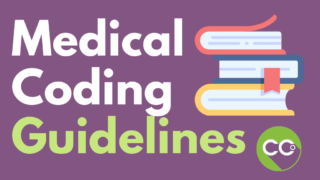 When auditing a medical practice, the first thing I notice is the poor choice of diagnosis codes used to describe a patient’s condition. A claim is supposed to tell a complete story so the payer can determine if the claim indicates medical necessity and whether or not a visit is a medical or liability case.
When auditing a medical practice, the first thing I notice is the poor choice of diagnosis codes used to describe a patient’s condition. A claim is supposed to tell a complete story so the payer can determine if the claim indicates medical necessity and whether or not a visit is a medical or liability case.
Let’s say that a patient is dealing with complications from an ankle fracture during follow-up care. Using the term “ankle fracture” as the primary diagnosis is not accurately indicating the chief complaint of the visit. So how would a coder know how to code in a situation like this? The answer is simple – read, underline, and learn how ICD-10-CM works.
The beginning of the manual provides a brief introduction to the history and future of ICD-10-CM as well as characteristics, descriptions of Volumes 1 and 2 and disease classifications and a step-by-step guide teaches you how to use the ICD-10-CM properly. Understanding the official coding conventions is extremely important. Without a solid comprehension of the abbreviations, symbols and notations, the code descriptions can be misinterpreted and used improperly to code a patient visit.
Medical Coding Guidelines
The Coding Guidelines are a set of rules that complement the official instructions within the ICD-10-CM manual. Often times, a medical coder gets stuck with a particular case and is unsure of what direction to take in order to accurately describe a patient’s encounter. The Coding Guidelines are designed to give additional instruction per section. The information provided in these guidelines is invaluable and is worth knowing what each section contains. (For students preparing for the CPC exam, be assured that many coding scenarios will point to the guidelines for correct answers asked on the exam.)
Let’s revisit the patient being treated for a complication after he fractured his ankle. How would that be coded? In Chapter 17, b.1) of the Coding Guidelines, a full explanation for coding acute fractures and aftercare is presented. Examples of active fracture care (800-829) are explained. Aftercare codes (subcategories V54.0, V54.1, V54.8 or V54.9) are used after the active treatment phase is completed and a list of aftercare descriptions is also provided in this section.
This patient, however, has a complication. A special notation states that care for complications for fracture repairs during the healing or recovery phase should be coded with the appropriate “complication” code. If the “complication” was a “malunion”, we would use 733.81- Malunion, Fracture as the primary diagnosis. This malunion is a “Late Effect” of the previously classified Open Ankle Bone Fracture – 825.31. However, we would not be using the Open Ankle Bone Fracture code. The second diagnosis would be 905.4 – Late Effect of Fracture, Lower Extremity (injury classifiable to codes 821-827).
Additional instructions on fractures include multiple fractures of the same limb, multiple unilateral or bilateral fractures of the same bone, multiple fracture categories 819 and 828, and lastly, multiple fracture sequencing of codes based on severity.
In summary, coders must know all the official coding guidelines in addition to the conventions. There are quite a few items to learn but preparing your book with highlights and tabs can help you maneuver around the various sections with ease. The information provided on coding for fractures is a consolidation of the actual guidelines on fracture care, and as you can see, there is quite a bit of information provided to sequence and code accurately. Medical coding courses taught by www.cco.us and www.aapc.com will teach you the proper way to use the ICD-10-CM manual and prepare you for your CPC exam as well as be your reference tool for future coding!
More Related Medical Coding Guidelines
![[CCO] Certification Coaching Organization LLC [CCO] Certification Coaching Organization LLC](https://www.cco.us/wp-content/uploads/2015/05/CCO-Logo-2015-d3-500px.png)
